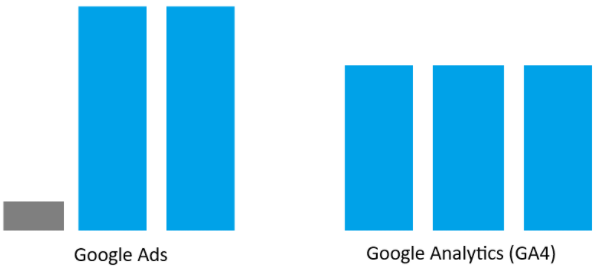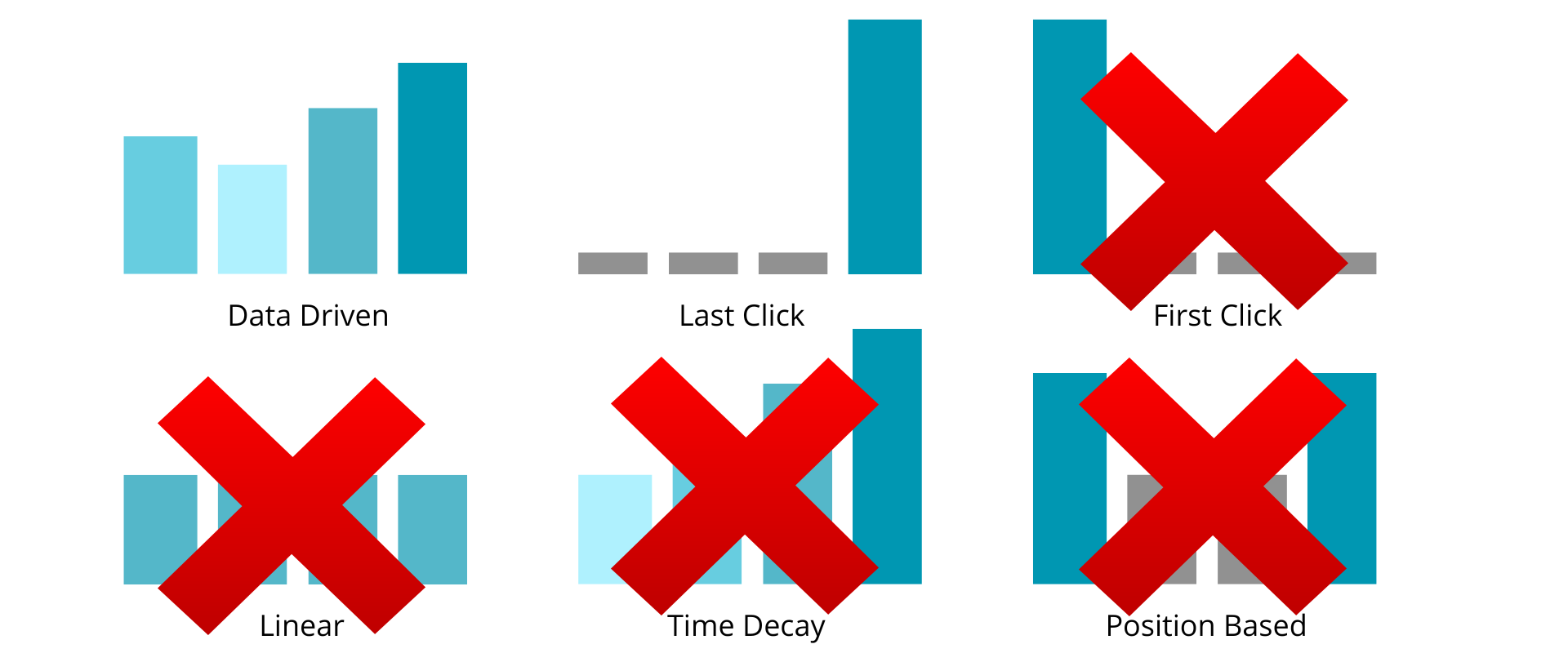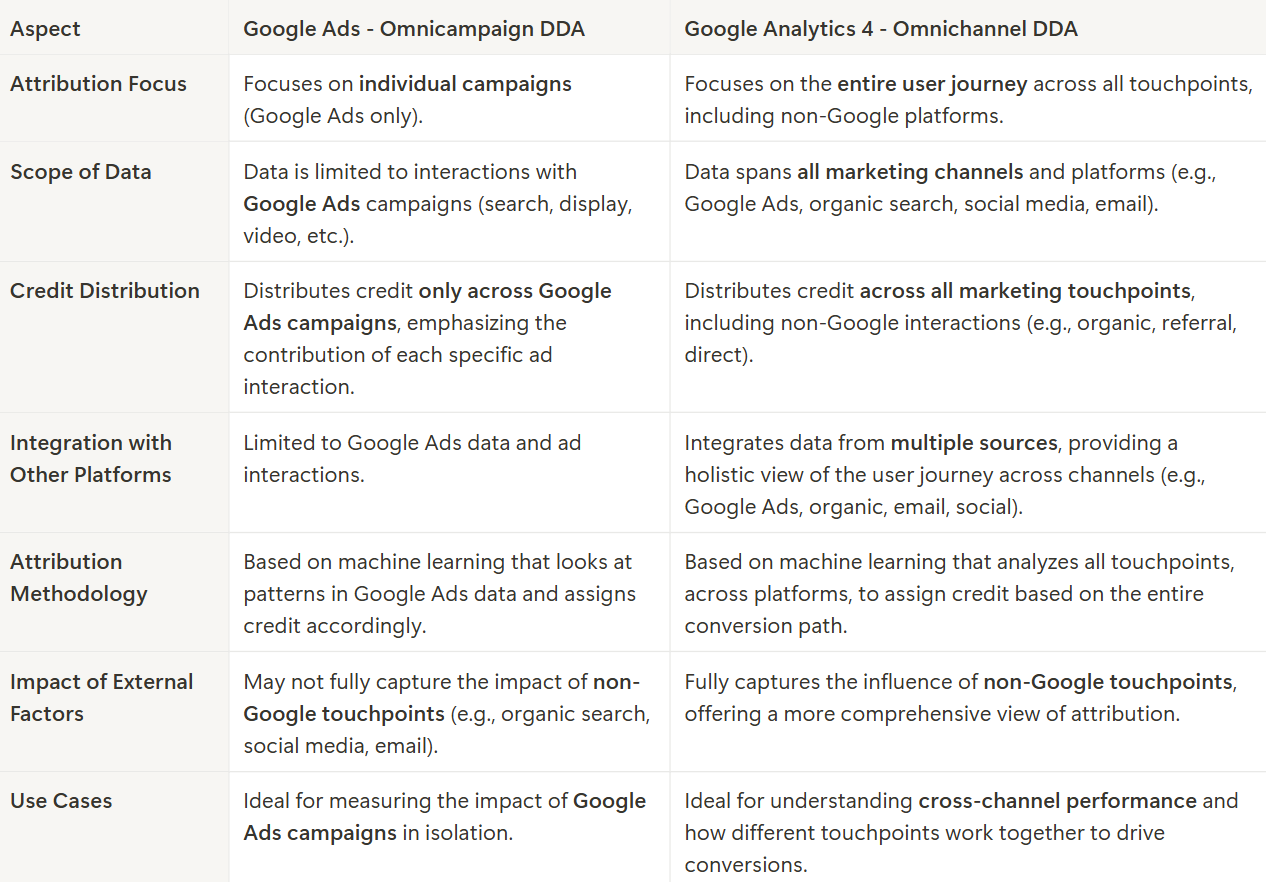
How Google Ads is Lying To You
Table of contents
Ever wondered why the conversion numbers in Google Ads and GA4 don’t seem to match up? It’s not a glitch—it’s all about how each system tracks and shares credit for sales.
Google Ads takes more credit than it deserves, which can give you a skewed view of what’s growing your business. Knowing which marketing channels bring in the most money to your business matters a lot because it influences where you decide to spend your marketing dollars.
Customers are going on more touchpoints than ever before making a purchase. A customer might first discover your business through a blog, and then see a video add, and finally click your Google Search ad, before finally making a purchase.

In this multi-touchpoint customer journey, can you guess how many conversions Google Ads would credit itself, on its platform? 1 full conversion.
Google Analytics (GA4) on the other hand would reflect reality a lot more closely, and would only credit Google Ads for something smaller, such as 0.67 conversions.

Why the difference? It all comes down to how Google Ads’ “Data-Driven Attribution” works—giving full credit within its platform, and then dividing conversions between campaigns after claiming the full sale. Even if you're using the same attribution model in Google Ads & GA4, such as Data-Driven Attribution, you will still see this discrepancy.
This is because Google Ads has an "Omni-Campaign" approach, and GA4 has an "Omni-Channel" approach. Google Ads assumes the whole sale first, then breaks down the sale by campaigns within your Google Ads account. Google Analytics on the other hand distributes the sale across different marketing channels, reflecting reality much closer.
In this post, we’ll break down the difference between the 2 attribution systems so you can better understand your data and make smarter decisions for your marketing strategy.

Need help with your Google Ads? Why not contact us?
Attribution models decide who gets credit for driving sales, which is the key to growing your business.
If you discover that Meta Ads are bringing in more sales than Google Ads, wouldn’t it make sense to shift some of your Google Ads budget to Meta instead? That’s exactly why understanding attribution matters.
At its core, marketing is about figuring out what works, what doesn't, scaling up the winners, and cutting out losers. Without a clear grasp of attribution, you’re essentially flying blind, unable to make the data-driven decisions that fuel success.
Both Google Ads and Google Analytics use similar attribution models, however they work in very different ways.
As of 2024, Google Ads and Google Analytics 4 (GA4) emphasize two main attribution models: Last Click and Data-Driven Attribution (DDA). While Last Click assigns all credit to the final interaction, DDA uses machine learning to distribute credit based on how each step influences conversions.

Data-Driven Attribution (DDA): This model uses machine learning to divide credit based on how each ad interaction contributes to the conversion process. It’s designed to give a more accurate picture of what’s driving results.
Last Click: All the credit goes to the final ad click right before the conversion. Simple, but it can overlook the bigger picture of the customer journey.
DDA offers deeper insights by reflecting the complexity of modern customer journeys, where people engage with multiple touchpoints before deciding. It helps advertisers understand which channels, campaigns, and keywords truly drive results. Google recommends DDA for its accuracy, and you can compare it with Last Click using the Attribution Models Comparison Report in both platforms.
However, there’s a key difference between Google Ads and GA4 DDA:
Google Ads DDA focuses solely on ad interactions within the Google ecosystem, making it omni-campaign.
GA4 DDA analyzes the entire marketing journey across all platforms, including organic search, social media, and email, making it omni-channel.
This distinction shapes how each platform evaluates conversions, helping businesses interpret data and make smarter marketing decisions.
GA4 is a more accurate representation of how much credit different marketing channels get, and as such are better references for business owners wondering which channels to invest more money into. GA4 provides a broader view of marketing performance by distributing conversion credit across all platforms and channels, not just ads. This omni-channel approach offers a clearer picture of how every touchpoint contributes to success.
Key Components of GA4's Omni-Channel DDA System:
Data Aggregation Across Channels:
Collects interaction data from paid search, organic traffic, email, social media, direct visits, and more using event-based tracking and Google’s tagging solutions.User Path Analysis:
Tracks and analyzes the full customer journey, logging metadata like timestamps and channel types for granular insights.Machine Learning Attribution Model:
GA4's machine learning algorithms identify patterns within the collected data to estimate the incremental impact of each touchpoint. The system considers the following factors:Sequence of Interactions: Assesses how touchpoints influence conversions.
Time Lag to Conversion: Prioritizes recent interactions without ignoring earlier ones.
Type of Interaction: Weighs high-value engagements (e.g., product views) over low-value ones.
Cross-Channel Interplay: Analyzes how channels work together to drive results.
Probability Attribution:
Assigns proportional credit by comparing the likelihood of conversion with and without specific touchpoints.Omni-Channel Insights:
Distributes credit across all touchpoints, including Google platforms (e.g., YouTube) and non-Google channels (e.g., Facebook, organic search, email).
Google Ads provides a more focused representation of how much credit individual Google campaigns deserve, making it a better reference for advertisers looking to optimize their spend specifically within the Google Ads ecosystem. The Data-Driven Attribution (DDA) system in Google Ads is tailored specifically for paid campaigns within the Google Ads ecosystem. Its omni-campaign design focuses on analyzing interactions across all eligible ad formats and campaigns.
Key Components of Google Ads' Omni-Campaign DDA System:
Conversion Tracking Data Collection: Google Ads relies on conversion tracking to collect data on user interactions with ads across campaigns. This involves:
Clicks and Impressions: Captures ad interactions with metadata like keywords and campaign IDs.
Conversion Actions: Tracks predefined goals using conversion tags and enhanced conversions.
Cross-Device Activity: Links interactions across devices using Google account data.
Machine Learning Attribution Model: Google Ads’ DDA system uses machine learning to allocate conversion credit across ad touchpoints. It considers:
Incrementality Testing: Measures a touchpoint’s impact by comparing users exposed to it versus those who weren’t.
Sequence and Context of Interactions: Weighs the order and timing of interactions. For example:
Search ads clicked closer to a conversion may receive more credit than those clicked earlier.
A YouTube video ad that introduced a user to the brand may also be credited if it played a significant role in driving further interactions.
Interaction Type and Value: Prioritizes high-value actions (e.g., product page visits).
The model adapts over time by learning from aggregated historical data and continuously optimizing attribution accuracy.
Credit Allocation: The DDA system assigns fractional credit to each ad interaction based on its calculated contribution to the conversion. For example:
A campaign that initiated the conversion path might receive 20% of the credit.
A retargeting Display ad shown to the user near the conversion may receive 30%.
The final Search ad click before conversion might be assigned the remaining 50%.
This granular allocation ensures that all relevant campaigns are recognized for their contributions, reflecting their true value in driving results.
Omni-Campaign Reporting: Google Ads provides detailed reporting tools to help advertisers analyze the role of each campaign in the conversion process:
Campaign-Level Contribution Analysis: Showing how different campaigns (e.g., Display, Search, Shopping) contributed to the conversion.
Path Reporting: Allowing advertisers to visualize common ad interaction paths leading to conversions.
Model Comparison Tool: Enabling advertisers to compare DDA with other attribution models (e.g., Last Click) to understand differences in credit allocation.
Summary of DDAs:

To understand how attribution works in practice, let’s look at a real-world example. Imagine a customer journey with multiple touchpoints—some inside the Google Ads ecosystem and others outside it.
Here's the scenario:
Step 1: User clicks an affiliate link from an external website (not part of Google Ads).
Step 2: User watches a Google Ads remarketing video (Campaign number 1).
Step 3: User subscribes after clicking an ad from one of our Performance Max campaigns (Campaign number 2).
How would this journey be attributed in Google Analytics 4 (GA4) versus Google Ads’ Data-Driven Attribution (DDA)? Let’s break it down.
1. GA4 Attribution (Omni-Channel Focus):
GA4 considers all interactions across every channel in the conversion path. Here’s how it attributes credit:
33% Credit to the Affiliate Link: GA4 recognizes the external affiliate link as the first touchpoint that initiated the user’s journey.
33% Credit to the Remarketing Campaign: GA4 also assigns part of credit to the remarketing video ad, which re-engaged the user and contributed directly to the subscription.
33% Credit to the PMAX Campaign: GA4 assigns the remaining credit to the Performance max campaign which directly led to the conversion event.
2. Google Ads Attribution (Omni-Campaign Focus):
Google Ads’ DDA focuses exclusively on paid campaigns within its ecosystem. The affiliate link is ignored, as it is outside Google Ads. The system allocates credit among eligible campaigns:
50% Credit to the Remarketing Video Campaign: Since this campaign directly interacted with the user, it gets half the conversion credit.
50% Credit to the Performance Max Campaign (PMAX): If PMAX played a role in indirectly supporting the remarketing campaign, it also receives credit.
In Google Ads, 100% of the conversion credit is distributed across its campaigns, ignoring non-Google touchpoints like the affiliate link.
Summary of Attribution:


Understanding the differences between Google Ads and GA4 attribution systems is key to making smarter, data-driven marketing decisions. While Google Ads focuses on giving credit within its own network, GA4 looks at the bigger picture, considering all the touchpoints across your customer’s journey. This means that while Google Ads helps you optimize ad campaigns, GA4 gives you a more comprehensive view of how different marketing channels contribute to your conversions.
Using Data-Driven Attribution in both platforms allows you to move beyond the basic Last Click model and get a clearer picture of what’s actually driving results. But it’s important to recognize that each system has its strengths. Google Ads is great for understanding how your different campaigns are performing relative to each other, while GA4’s omni-channel approach shows how every interaction—from paid ads to organic search and social media—fits into the bigger picture.
With a clearer understanding of attribution, you can make more informed decisions on where to invest your budget, optimize your campaigns, and ultimately grow your business. In the end, attribution isn’t just about tracking conversions; it’s about understanding what truly drives success and using that knowledge to fuel your marketing strategy.
